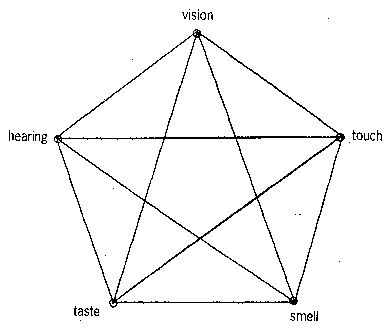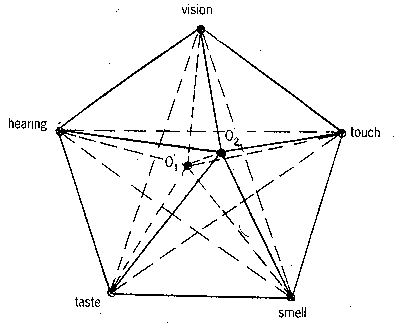
In any branch of science, and in aesthetics in particular, the essence, nature and specific character of individual phenomena taken by themselves are studied thoroughly in exact detail. For example, in a manual of esthetics, one can find Art form system and in a manual of psychology - Organs of sense system. However, it is difficult for science to comprehend relationships and interactions between these two phenomena. And it is impossible to know much about genesis without it, such as the dynamics and history of development of any system and its components. Similarly, it is impossible to comprehend the integral nature of the whole system or even try to pretend to prognosticate. Considering this helplessness in the methodological basis for such a science, the disassociation of knowledge and the specialization in sciences continue to pretend mastery of complex subjects. The most striking example of this helplessness is the investigation of problem of synesthesia in the arts.
The term synaesthesia came into art theory vocabulary over100 years ago. Now it is quite popular in aesthetics, although there still is no uniform definition of its bounds. Synesthesia is first of all Intersensory psychological relationships, as they are displayed in concrete fields:
Expressions like of Rimbaud's A-red color are examples of literary synesthesia, the paintings by Chiurlionis and Kandinsky of pictorial synesthesia, and the compositions by Debussy and Rimsky-Korsakov of musical synesthesia. These works imply the existence of particular synaesthetic genres, such as musical painting, light-music and synesthetic film.
How can the shortcomings of this discordant terminology be overcome?
Firstly, synaesthesia must be considered within the context of subjects, such as physiology, psychology, linguistics, poetics, musicology, art criticism and aesthetics, remembering the possible conditioning of synesthesia to basic psychological phenomena.
The situation is more complicated than simply comprehending the nature of intersensory relationships themselves. Errors in analysis project into higher level subjects, art, with results contradicting not only science, but common sense as well.
Art theory has long renounced one-sided, mechanistic, physiologic, psychologic, psychoanalytic and other more mystic or agnostic explanations for itself. Noone would seriously accept any explanatory laws of beauty based on numerical proportions or elementary associations, such as Fechner.
Noone agrees with the naive interpretations of artistic creativity as genius insanity or the notorious libido sewage notion. As for synaesthesia, searches for explanations in physics and anatomy , display an atavism or psychiatric anomaly. Drug-induced inspiration and esoteric psychic explanations continue to be given, not only in popular press, but in doctoral level dis-sertations and encyclopaedias, as well. All this without the slightest mention of artists like Rimbaud, Baudelaire, Scriabin and Rimsky-Korsakov, Kandinsky or Chiurlionis. Synaesthesia is considered, by these interpretors, as an anomaly without positive sign, and placed somewhere at an over-, outer- or pre- conscious level, outside the limits of the normal human psyche and outside the norms of art.

Fig.1.
Synaesthesia may be considered as interactions in polysensory system. It should be emphasized that not only external exteroreceptive sensations, such as hearing, sight, etc.(fig.1.), but internal interoreceptive sensations are at work, as points O1 and O2 in the figure illustrate (fig.2.). Interoreceptive sensations cause internal state changes in physical organs resulting in how one feels himself. In addition, relational proprioreceptive sensations impact the location of the body in space, as in the case of vestibular and weight perception.

Fig.2.
Research has not given much importance of these internal sensations in the formulation of the concept of Synaesthesia and has been limited, in general, to the study of more exotic exteroreceptive intersensory relationships, such as color hearing in music. The presence of subtler sensations, at the center of the second figure, effect more significant intersensory relationships, as an audio synaesthesia, the notions of light and heavy sounds or high and low tones.
The literal etymological deciphering of the synaesthesia concept as a co-sensation does not correspond to the reality of this phenomenon. Synesthesia is rather co-idea, co-image, co-feeling and not doppel Empfindungen but doppel Vorstellung. It is a product of creative imagination. By its nature, it is an psychological association, an intersensory association. These are not imply associations of configuration. They are the more complex associations by resemblance; resemblance in form and structure. Synaesthetic analogies, such as melody-drawing are based upon this resemblance. Resemblance may also be based on content or emotional effect, as in timbre-color and tonality-coloring. Finally, there is the type of synaesthesia that is most common to art, the linking role of the higher social values to form synaesthesia.
In this form of synaesthesia, higher cognitive processes participate, even if they may operate at a subconscious level. This kind of synaesthesia is a form of non-verbal thinking, as is visual and musical thinking. Audio-visual synaesthesia forms relationships between visual and musical thinking.
As a specific form of interaction in an integrated perception system, synesthesia displays an essential human ability. Synesthesia is not some epiphenomenon. It is not an anomaly. It is the norm, though not always evident, in scientific analysis because of the special character of its origin. Moreover, synesthesia can be characterized as concen trated and simultaneous human sensuality across a broad spectrum sensations. There are sensory couplings, and emotions mediating these couplings. Here lies the explanation why art is where synesthesia has been cultivated and functions as a social practice. To comprehend the essence of art, itself, is to understand universal human sensuality in its integraty and harmony, as it has evolved century after century.
Synaesthesia is an essential characteristic of artistic thinking promoting the realization of mediating compensation for the incompleteness of sensuality, itself. The relative indifference of an artistic image to specific limited nature of its form and the universality of artistic phenomenon can be explained through a synaesthetic analysis. Concurrently, all art operates in a synaesthetic complex, those inherent to its particular form and a synaesthetic fund of a common artistic space-time. Some of the most common relationships, in this synaesthetic fund, between the audible and visible worlds in art are:
Dynamics in music -
Dynamics of gesture, both its movement in space and changing in brightness
Melodic development - Character and dynamics of drawing
Music tempo
- Speed of movement and transformation of visual images
Music rhythm and meter - Spatial and temporal accents in the visual arts
Timbre development - Color development
Tonality change
- Development of coloring of the whole picture or color plane
Mode changing
(minor and major shifts) - Lightening ordarkening
The synaesthetic fund for each art form continuously changes. Through a process of revision, its structure and content evolve the expressiveness of a media by interacting with the other arts. The interplay between this interdependency of the arts and specificity of art forms causes a synchronism in the artistic need to form a synthesis of arts and the emergence of conditions for its realization, such as the theater of the 17th and 18th centuries, and the motion pictures of the 20th century.
The necessity to study of synaesthesia, its regularities and functions in art, is particularly important when considering a new artificial media in which both sound and image are synthesized, as is the case with electronic and computer art. The issues of subjugation to technology and subjugation to the computer must be raised. We should not proceed into these forms of art without a basic knowledge the nature and peculiarities of synaesthesia.
(Published in "Languages of Design", 1(1993), pp.201-203)